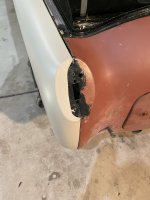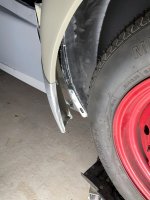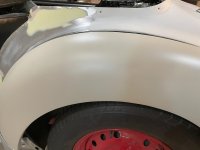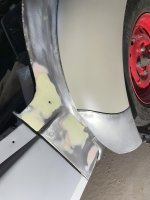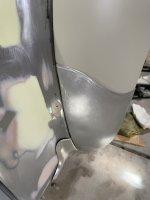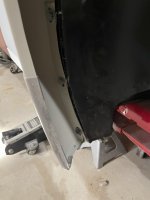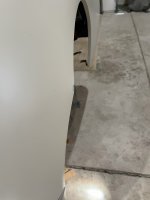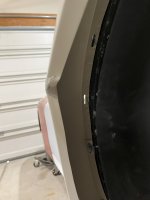First trial fitting of a brand new left rear wing/fender (purchased from Rimmer Bros.) on my 1955 Triumph TR2 restoration project.
It seems as though the fender is too long or the curve in the front is too wide.
After attaching this fender from the back first and adding each screw/bolt moving forward, all of the bolt holes line up just right.
But as I get the front part that begins to curve downward, the front of the fender sits too far forward.
The last 5 bolt holes to get to the bottom of the front of the fender do not line up.
I do not want to try to push the front part of the fender back, as I do not want damage this "brand new" fender.
Do I need to push/pull the middle or rear section of the fender outward (away from the body)?
I see that when I do this the front part seems to move closer to aligning correctly.
So, I am looking for some advice about how to properly align this fender without damaging it.
Has anyone else seen this type of problem?
As always, any advice, direction or suggestion is appreciated.
It seems as though the fender is too long or the curve in the front is too wide.
After attaching this fender from the back first and adding each screw/bolt moving forward, all of the bolt holes line up just right.
But as I get the front part that begins to curve downward, the front of the fender sits too far forward.
The last 5 bolt holes to get to the bottom of the front of the fender do not line up.
I do not want to try to push the front part of the fender back, as I do not want damage this "brand new" fender.
Do I need to push/pull the middle or rear section of the fender outward (away from the body)?
I see that when I do this the front part seems to move closer to aligning correctly.
So, I am looking for some advice about how to properly align this fender without damaging it.
Has anyone else seen this type of problem?
As always, any advice, direction or suggestion is appreciated.

 Hi Guest!
Hi Guest!

 smilie in place of the real @
smilie in place of the real @
 Pretty Please - add it to our Events forum(s) and add to the calendar! >>
Pretty Please - add it to our Events forum(s) and add to the calendar! >> 
